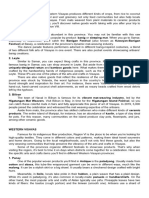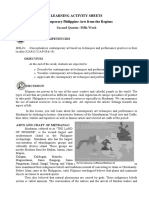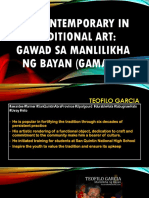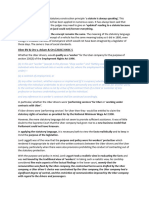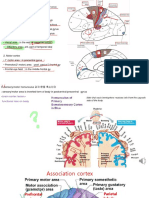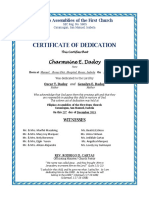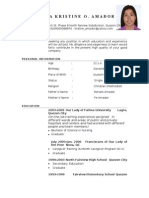Arts of Cordillera Administrative
Arts of Cordillera Administrative
Uploaded by
lex bactolCopyright:
Available Formats
Arts of Cordillera Administrative
Arts of Cordillera Administrative
Uploaded by
lex bactolCopyright
Available Formats
Share this document
Did you find this document useful?
Is this content inappropriate?
Copyright:
Available Formats
Arts of Cordillera Administrative
Arts of Cordillera Administrative
Uploaded by
lex bactolCopyright:
Available Formats
MANUEL V.
GALLEGO
FOUNDATION COLLEGES, INC.
Name: Alexander A. Bactol CPA
Grade/Section: XII-Galileo MINI TASK
“Arts of Cordillera Administrative Region”
When we hear the place Cordillera Administrative Region, one thing will always come first to our minds. And it is
they are rich in various art and crafts forms. And that is indeed true. In fact, the region of cordillera has so many diverse
contemporary art forms. The first on the list is the famous cordillera weaving. The C.A.R is always known for its high-quality
weave cloth. They highly give value to cloth weaving because the use of cloth is involved in life from birth to death, in
sickness and health. A baby is cocooned in cloth. The sick is wrapped and healed in it. Couples are clasped in it and in
death, one is buried in it. Identity is defined when the members of a group make and wear clothing that distinguishes them
from others. Dressing styles indicate different ethnic origins. As an art form, textiles are embedded in all aspects of life from
day-to-day situations to the performance of rituals. This is how the Cordilleras gives importance to these contemporary art
forms that they have. The second on the list is wood carving and bamboo crafts. The Baguio City is always known for its
hard quality sculptured. In fact, since the '70s, they are known for their wood-carved images sold in the city market stalls.
Woodcarving, however, did not have its roots in the City. Folktale had it that woodcarving was linked to the Ifugao religion
and not for ornamentation. Wigan the god of the Skyworld showed Wigan the Ifugao of Hapao how to carve a bulul to guard
their rice granary (Lambrecht 1981). And the last but not the least is their traditional way of putting tattoo. This is they were
popular at, embodying art to the body of an individual. As a matter of fact, the ancient art of tattooing is inspired by tradition
throughout the Cordilleras. One of the most famous of all tattoo artisans is the great Maria Oggay, more popularly known to
the world by her native name Apo “Whang-od.” She lives in Buscalan, Tinglayan, Kalinga, and accommodates visitors daily
—tapping on the skin and marking her patrons with her amazing art. Apo Whang-od is also known as “the last and oldest
mambabatok” in Kalinga and is a part of the Butbut tribe. For the traditional Cordilleran, a tattoo is earned through bravery
and courage while the women see it as an expression of beauty.
We can really see that the Cordillera’s contemporary art form is beautifully unique from the others. From the making
of clothes, which they do by weaving. Which is kind of unusual, especially in today’s time. The wood carving, Cordillerian
uses strong and hard materials to curve statute and deities. And, it's traditional way of inking the body. To express
themselves and convey the art of true beauty. It was indeed mesmerizing to study and understand the contemporary art
forms of Cordillera. They really value the things that their ancestors left to them. And I hope that even many decades will
pass by, they will still give importance to it and continue practicing it.
You might also like
- CANON Service Manual iPF780 760 750 Series iPF785 PDFDocument326 pagesCANON Service Manual iPF780 760 750 Series iPF785 PDFNicola FontanellaNo ratings yet
- Cpar Group 9Document28 pagesCpar Group 9teptepqw123No ratings yet
- Corillera Heritage Night 2019Document4 pagesCorillera Heritage Night 2019Lorraine Alunday Ngao-iNo ratings yet
- Group 6 ArtsDocument34 pagesGroup 6 ArtsJanine CrisoloNo ratings yet
- Power PointDocument48 pagesPower PointMarken Iranzo EbiteNo ratings yet
- (CPAR) Module 7 - Living With The ArtistsDocument2 pages(CPAR) Module 7 - Living With The Artistsjamaicacamulo06No ratings yet
- Art Appreciation Reviewer2nd Sem 1Document6 pagesArt Appreciation Reviewer2nd Sem 1Barrientos Lhea ShaineNo ratings yet
- Unit I - Lesson 1 & Lesson 2Document61 pagesUnit I - Lesson 1 & Lesson 2Haydee CarpizoNo ratings yet
- Barayuga Mark JamesDocument11 pagesBarayuga Mark JamesMark James Bugarin BarayugaNo ratings yet
- Las CparDocument3 pagesLas CparJennyben Suminguit MacanNo ratings yet
- GAMABADocument2 pagesGAMABAFaith TimolaNo ratings yet
- 4 Unit 1 Lesson3 6 Context of ArtDocument69 pages4 Unit 1 Lesson3 6 Context of Art20.TRISHA ANN SANTOSNo ratings yet
- ARTs and Crafts L1Document47 pagesARTs and Crafts L1Daisy Timajo ValledorNo ratings yet
- Group 3 - IsabelaDocument16 pagesGroup 3 - IsabelaAlthea ManlapazNo ratings yet
- GAMABADocument18 pagesGAMABAKissler CuervoNo ratings yet
- Contemporary Arts Week 78Document7 pagesContemporary Arts Week 78jayveenalsoclaritNo ratings yet
- Notes in ContemporaryDocument19 pagesNotes in Contemporarymede quizoNo ratings yet
- LESSON 2 Trraditional TechniquesDocument48 pagesLESSON 2 Trraditional Techniquesaleckaladee.cruzata-16100% (1)
- Arts Unit 2Document21 pagesArts Unit 2Haydee CarpizoNo ratings yet
- GawadDocument18 pagesGawadKissler CuervoNo ratings yet
- Contemporary Arts in The PhilippinesDocument6 pagesContemporary Arts in The PhilippinesKaren Jamito MadridejosNo ratings yet
- WeavingDocument10 pagesWeavingPearl Hazel Neri CamargoNo ratings yet
- Folk Arts of Calabarzon and MimaropaDocument12 pagesFolk Arts of Calabarzon and MimaropaApril PinedaNo ratings yet
- Module in Indigenous Creative CraftsDocument6 pagesModule in Indigenous Creative CraftsJerald HuindaNo ratings yet
- Fact or BluffDocument46 pagesFact or BluffLei DulayNo ratings yet
- Group1 Unit-5Reporting FinalDocument48 pagesGroup1 Unit-5Reporting Finalxuxi babeNo ratings yet
- BicolDocument12 pagesBicolziyachoi17No ratings yet
- Filipino Artist and Their Contribution To Contemporary Arts - Group 4Document29 pagesFilipino Artist and Their Contribution To Contemporary Arts - Group 4jeromemallorca10No ratings yet
- Eastern VisayasDocument7 pagesEastern VisayasJerald HuindaNo ratings yet
- Folk Arts and Design From LuzonDocument37 pagesFolk Arts and Design From LuzonArt Albay75% (12)
- Module 2 in ContemporaryDocument12 pagesModule 2 in ContemporarySirLance ValerioNo ratings yet
- He001-Module 6Document8 pagesHe001-Module 6Janel Buhat GrimaldoNo ratings yet
- Module 3 Lesson 2Document6 pagesModule 3 Lesson 2Jervis Joyce Partoza RodajeNo ratings yet
- Claret College of Isabela: Junior High SchoolDocument4 pagesClaret College of Isabela: Junior High SchoolCriohn MohamadNo ratings yet
- Presentation1living ArtistDocument25 pagesPresentation1living Artistarnelyngalvez4No ratings yet
- 4 Long CPAR - MODULE 9-10 - q2Document18 pages4 Long CPAR - MODULE 9-10 - q2Criselda MantosNo ratings yet
- Ho Arts 7Document3 pagesHo Arts 7Michelle Anne Legaspi Bawar75% (4)
- Art App Midterm 5Document52 pagesArt App Midterm 5vans off the wallNo ratings yet
- Art Forms Found in Negros OccidentalDocument11 pagesArt Forms Found in Negros OccidentalCaryl Ann EncaboNo ratings yet
- LAS - Contemporary Artsweek 5Document12 pagesLAS - Contemporary Artsweek 5esterlitaNo ratings yet
- The Art of Region 6Document4 pagesThe Art of Region 6patriciaLimos100% (8)
- Aguinaldo, Katherine C. BSOA 1107: Gamaba ArtistDocument2 pagesAguinaldo, Katherine C. BSOA 1107: Gamaba ArtistefshdrsfsfeNo ratings yet
- Lesson 2 Arts 4Document9 pagesLesson 2 Arts 4Grace DignosNo ratings yet
- Final Comtemp Art 1Document55 pagesFinal Comtemp Art 1Jerimae Jean BedoniaNo ratings yet
- Page 107 113 CONTEMPORARY PHILIPPINE ARTS FROM THE REGIONDocument26 pagesPage 107 113 CONTEMPORARY PHILIPPINE ARTS FROM THE REGIONMrndyrNo ratings yet
- History Additional ReadingDocument8 pagesHistory Additional ReadingCatherine QuilizaNo ratings yet
- Cultural SensitivityDocument26 pagesCultural SensitivityLyra HolguinNo ratings yet
- Cordillera ArtsDocument18 pagesCordillera ArtsCharlene Fadrigon-OtazuNo ratings yet
- GAMABADocument9 pagesGAMABAJhoe Anne B. LimNo ratings yet
- Q3 Arts Day 1Document37 pagesQ3 Arts Day 1Rochelle Iligan Bayhon80% (5)
- Contemporary Arts WK 8Document4 pagesContemporary Arts WK 8Alice C. RiveraNo ratings yet
- Gamaba AwardeesDocument2 pagesGamaba AwardeesJessaNo ratings yet
- MooyDocument3 pagesMooyMiko Jane EstemberNo ratings yet
- Arts ReviewerDocument13 pagesArts ReviewerS'Vaughn IgnacioNo ratings yet
- Lesson 1 & 2Document4 pagesLesson 1 & 2Celemin CuajotorNo ratings yet
- GAMABADocument28 pagesGAMABANadia Wan100% (1)
- Cor 012 Reviewer 3Document3 pagesCor 012 Reviewer 3garciavannelieNo ratings yet
- Quarter 1 MODULE 4 Arts and Crafts of CALABARZON and Bicol RegionDocument20 pagesQuarter 1 MODULE 4 Arts and Crafts of CALABARZON and Bicol RegionERNALYN GEM GEM G. RAFER-PANDI100% (1)
- LM Arts 7 Week 3Document4 pagesLM Arts 7 Week 3Gen TalladNo ratings yet
- List of Publishers - Scholarly Open AccessDocument21 pagesList of Publishers - Scholarly Open AccessCarmen NelNo ratings yet
- Xi - Accounting: PrivateDocument15 pagesXi - Accounting: PrivateAdnan SajidNo ratings yet
- The Rothschild Dynasty UnraveledDocument2 pagesThe Rothschild Dynasty Unraveledparisblast288No ratings yet
- Tackling Teacher Turnover in Child Care Understanding Causes and Consequences Identifying Solutions PDFDocument9 pagesTackling Teacher Turnover in Child Care Understanding Causes and Consequences Identifying Solutions PDFBuat Duit Masa MudaNo ratings yet
- UBER BV V AslamDocument2 pagesUBER BV V AslamkarishanmuNo ratings yet
- Brodmann (1909) : Classify Cerebral Area (52 Area) by Cytoarchitecture of CortexDocument10 pagesBrodmann (1909) : Classify Cerebral Area (52 Area) by Cytoarchitecture of Cortexjake paulNo ratings yet
- Esbc 13 11072014 PDFDocument12 pagesEsbc 13 11072014 PDFEr Dhananjay PawaseNo ratings yet
- COOKERY 10 MeatDocument2 pagesCOOKERY 10 MeatKC Tolentino CahanapNo ratings yet
- Dadoy Certificate of DedicationDocument2 pagesDadoy Certificate of DedicationJhedz CartasNo ratings yet
- Obiee Training - Obiee Course ContentDocument5 pagesObiee Training - Obiee Course ContentParvez2zNo ratings yet
- Acc271215 OhdDocument4 pagesAcc271215 Ohdbasilimagambo22No ratings yet
- O R D E R P L A N I N G: Colour Wise Size Wise Packing RatioDocument11 pagesO R D E R P L A N I N G: Colour Wise Size Wise Packing RatioAmbalavanan ChockalingamNo ratings yet
- Marketing Analytics Optimize Your Business With Data Science in R Python and SQL All Chapter Instant DownloadDocument34 pagesMarketing Analytics Optimize Your Business With Data Science in R Python and SQL All Chapter Instant Downloadmonulecaumol100% (5)
- Brymor HotelsDocument24 pagesBrymor HotelsADEMILUYI SAMUEL TOLULOPENo ratings yet
- Fall Calendar 5778Document1 pageFall Calendar 5778Anonymous 41ryI5tNo ratings yet
- Essay On A MotherDocument4 pagesEssay On A Motherohhxiwwhd100% (2)
- Tin ResumeDocument4 pagesTin Resumekrstine_amadorNo ratings yet
- Self CarDocument36 pagesSelf CarJun Vincent AbaoNo ratings yet
- Tally Solutions - Corporate BrochureDocument14 pagesTally Solutions - Corporate BrochurePeter RonaldNo ratings yet
- Ketab Otomasion Sanati Mazaia V Karbord An Dar Sistem Ha - (WWW - Wikipower.ir)Document560 pagesKetab Otomasion Sanati Mazaia V Karbord An Dar Sistem Ha - (WWW - Wikipower.ir)hrme80No ratings yet
- Monster Girl Catcher 2 - Hankyu HikaruDocument234 pagesMonster Girl Catcher 2 - Hankyu HikarukqgrctfqofustoxmfoNo ratings yet
- Capital Budgeting Decisions Under Uncertainity - 1 - 09 - 2019Document55 pagesCapital Budgeting Decisions Under Uncertainity - 1 - 09 - 2019Kaushik meridianNo ratings yet
- High CholesterolDocument31 pagesHigh Cholesterolashoku2100% (2)
- Modulo 2Document6 pagesModulo 2GladysRamírezNo ratings yet
- Alcohol Exam February 2024Document6 pagesAlcohol Exam February 2024Alfee KariukiNo ratings yet
- BHM 704CTDocument111 pagesBHM 704CTAbhishek ChowdhuryNo ratings yet
- Sodium BenzoatDocument7 pagesSodium BenzoatYono FabiandiNo ratings yet
- Oxitocina y Dinero Ernst FehrDocument1 pageOxitocina y Dinero Ernst FehrDORIS JANETHNo ratings yet
- Cubic Spline v101Document2 pagesCubic Spline v101Qiang LiuNo ratings yet




























